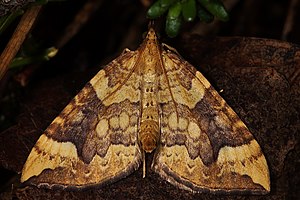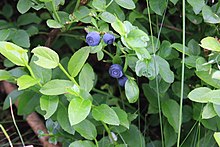Variable hair tuft tensioner
| Variable hair tuft tensioner | ||||||||||||
|---|---|---|---|---|---|---|---|---|---|---|---|---|

Variable hair-tuft tensioner ( Eulithis populata ), dark shape |
||||||||||||
| Systematics | ||||||||||||
|
||||||||||||
| Scientific name | ||||||||||||
| Eulithis populata | ||||||||||||
| ( Linnaeus , 1758) |
The changeable hair-tuft spanner ( Eulithis populata , syn .: Lygris populata ) is a butterfly ( moth ) from the spanner family (Geometridae). The species name is derived from the Latin word populus meaning " poplar " and refers to a food plant of the caterpillars.
features
butterfly
The moths reach a wingspan of 24 to 35 millimeters. As the common name suggests, the color of the butterflies is extraordinarily variable. The basic color of the upper side of the forewing varies from purple-brown to ocher-yellow. A yellowish band extends between the basal region and the midfield. The midfield protrudes towards the hem in two spikes. The fringes are always unchecked. A yellowish, approximately triangular field begins at the apex . The upper side of the hind wing is pale yellow without drawing.
Caterpillar
Adult caterpillars are also extremely variable in color and have a whitish, yellowish, greenish, brownish, blackish or reddish color. They are most likely to be recognized by the dark back line on the anterior segments, the also dark wedge spots on the posterior segments and the clear, ring-shaped brown thickening of the second body segment.
Similar species
- The honey-yellow hair-tuft spanner ( Eulithis mellinata ) differs in most specimens by the less distinctive drawing on the upper side of the forewing . However, the main distinguishing feature is the brown / white piebald fringes.
- The brownish-yellow hair-tuft tensioner ( Eulithis testata ) differs through a wavy middle field without protruding prongs.
Distribution and occurrence
The distribution area of the changeable hair-tuft spanner stretches from Spain across western and central Europe and the British Isles eastwards to the Amur and Kamchatka . The northern distribution extends beyond the Arctic Circle . The species is also found in North America. The main habitat are blueberry and mixed forests, clearings, embankments and wetlands. The altitude distribution reaches up to 2500 meters in the Alps and up to 2300 meters in the Pyrenees .
Way of life
The mostly crepuscular and nocturnal moths fly in one generation from June, mainly in the months of July and August, and in the mountains until October. Occasionally they can also be found during the day. However, during the day they mostly rest in the herb layer or in dwarf shrubs. In its typical resting position, the end of the abdomen is bent slightly upwards. At night they visit artificial light sources . Sometimes they were in large numbers while sucking to the flowers of Blue Moorgrass ( Molinia caerulea ), honey grasses ( Holcus ), Juncus Conglomeratus ( Juncus conglomeratus ) and flap bulrush ( Juncus effusus observed). The species overwinters in the egg stage. The caterpillars feed primarily on the leaves of the bilberry ( Vaccinium myrtillus ). Alternative food crops are bogberry ( Vaccinium uliginosum ), red currant ( Ribes rubrum ) as well as willow ( Salix ) and birch ( Betula ). Caterpillars have also been found on the trembling aspen ( Populus tremula ).
Individual evidence
- ^ Arnold Spuler : The Butterflies of Europe , Volume 2, E. Schweizerbart'sche Verlagsbuchhandlung, Stuttgart, 1910, p. 38
- ↑ a b c Axel Hausmann & Jaan Vidalepp: The Geometrid Moths of Europe Volume 3 Subfamily Larentiinae I , Apollo Books, Aamosen, 2012, ISBN 978-87-88757-39-2 , pp. 267/268
- ↑ a b c d Günter Ebert (Ed.): The butterflies of Baden-Württemberg. 1st edition. Volume 8. Moth VI. Geometridae 1 Ulmer, Stuttgart 2001, ISBN 3-8001-3497-7 , pp. 333-335
- ↑ a b Distribution worldwide and food plants [1]
- ^ A b Walter Forster & Theodor A. Wohlfahrt : The butterflies of Central Europe, Volume 5, Spanner. (Geometridae). Franckh'sche Verlagshandlung, Stuttgart 1981, ISBN 3-440-04951-5 , p. 84
- ↑ Manfred Koch , Wolfgang Heinicke, Bernd Müller: We determine butterflies. Volume 4: Spanner. 2nd, improved and enlarged edition. Neumann, Leipzig / Radebeul 1976, DNB 780451570 , pp. 106/107
- ↑ Arno Bergmann: The large butterflies of Central Germany. Volume 5/1: Spanner. Distribution, forms and communities. Urania-Verlag, Jena 1955, DNB 450378403
literature
- Axel Hausmann & Jaan Vidalepp: The Geometrid Moths of Europe Volume 3 Subfamily Larentiinae I , Apollo Books, Aamosen, 2012, ISBN 978-87-88757-39-2
- Walter Forster & Theodor A. Wohlfahrt: The butterflies of Central Europe, Volume 5, Spanner. (Geometridae). Franckh'sche Verlagshandlung, Stuttgart 1981, ISBN 3-440-04951-5
- Günter Ebert (Ed.): The butterflies of Baden-Württemberg. 1st edition. Volume 8. Moth VI. Geometridae 1 Ulmer, Stuttgart 2001, ISBN 3-8001-3497-7
Web links
- Lepiforum e. V. - Taxonomy and photos
- pyrgus.de - Butterflies and their ecology
- kolumbus.fi - caterpillar
- britishlepidoptera - Northern Spinach near British Lepidoptera
- fauna-eu.org - Fauna Europaea

